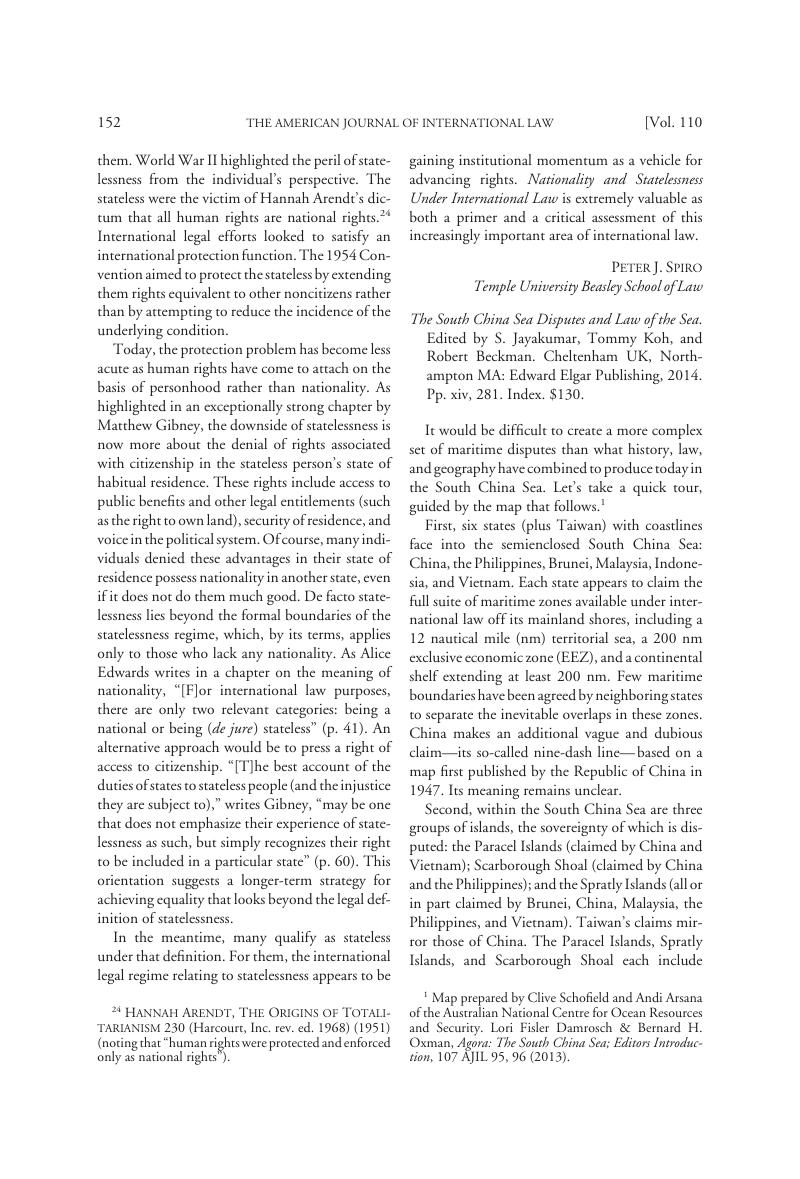Published online by Cambridge University Press: 20 January 2017

The views expressed herein are those of the reviewer and do not necessarily reflect the views of the U.S. government.
1 Map prepared by Clive Schofield and andi Arsana of the Australian National Centre for Ocean Resources and Security. Lori Fisler Damrosch & Oxman, Bernard H., Agora: The South China Sea; Editors Introduction, 107 AJIL 95, 96 (2013)Google Scholar.
2 UN Convention on the Law of the Sea, Art. 121(1), opened for signature Dec. 10, 1982, 1833 UNTS 396, available at http://www.un.org/Depts/los/index.htm [hereinafter UNCLOS].
3 Id., Art. 121(2).
4 Id., Art. 121(3) (stating that “[r]ocks which cannot sustain human habitation or economic life of their own shall have no exclusive economic zone or continental shelf”).
5 Albert F. del Rosario, Republic of the Philippines Secretary of Foreign Affairs, Concluding Remarks Before the Permanent Court of Arbitration, Peace Palace, The Hague (Nov. 30, 2015), at http://www.dfa.gov.ph/newsroom/dfa-releases/8087.
6 See, e.g., U.S. Dep’t of State Press Statement No. 2012/1263, Statement by Acting Deputy Spokesperson Patrick Ventrell, South China Sea (Aug. 3, 2012), at http://www.state.gov/r/pa/prs/ps/2012/08/196022.htm.
7 Republic of the Philippines v. People’s Republic of China, PCA Case No. 2013-19 (UNCLOS Annex VII Arb. Trib. filed Jan. 22, 2013), at http://www.pca-cpa.org.
8 North Sea Continental Shelf (FRG/Den.; FRG/Neth.), 1969 ICJ Rep. 3, para. 96 (Feb. 20).
9 See, e.g., U.S. Dep’t of State Press Statement No. 2011/1230, Statement by Hillary Rodham Clinton, Secretary of State, The South China Sea, para. 8 (July 22, 2011), at http://www.state.gov/secretary/20092013clinton/rm/2011/07/168989.htm [hereinafter Clinton Statement].
10 Agora: The South China Sea, supra note 1, at 95–163.
11 U.S. Dep’t of State, Bureau of Oceans and Int’l Envtl. & Sci. Aff., Limits in the Seas No. 143, China: Maritime Claims in the South China Sea (Dec. 5, 2014), at http://www.state.gov/documents/organization/234936.pdf (listing Kevin Baumert & Brian Melchior as principal analysts) [hereinafter Limits in the Seas No. 143].
12 Citing Gao, Zhigou & Jia, Bing Bing, The Nine-Dash Line in the South China Sea: History, Status, and Implications, 107 AJIL 98, 99, 123, 124 (2013)CrossRefGoogle Scholar.
13 See Limits in the Seas No. 143, supra note 11, at 10, 17–22.
14 Permanent Court of Arbitration Press Release, Arbitration Between the Republic of the Philippines and the People’s Republic of China (Oct. 29, 2015), at http://www.pcacases.com/web/sendAttach/1503. Additional claims by the Philippines will be considered in conjunction with the merits.
15 Republic of Philippines v. People’s Republic of China, Award on Jurisdiction and Admissibility, paras. 398–404 (Perm. Ct. Arb. Oct. 29, 2015), available at http://www.pcacases.com/web/sendAttach/1506.
16 See, e.g., Clinton Statement, supra note 9, para. 8 (emphasis added).
17 Law on the Territorial Sea and the Contiguous Zone, Art. 3 (Feb. 25, 1992) (China) (emphasis added), available at http://www.un.org/depts/los/LEGISLATIONANDTREATIES/PDFFILES/CHN_1992_Law.pdf [hereinafter China’s Territorial Sea Law].
18 UNCLOS, supra note 2, Art. 5.
19 China’s Territorial Sea Law, supra note 17, Art. 2.
20 Helene Cooper & Jane Perlez, White House Moves to Reassure Allies with South China Sea Patrol, but Quietly, N.Y. Times, Oct. 28, 2015, at A7.
21 Gao & Jia, supra note 12 and accompanying text.
22 UNCLOS, supra note 2, pmbl.
23 The views expressed herein are those of the reviewer and do not necessarily reflect the views of the U.S. government.